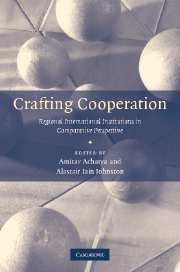Book contents
- Frontmatter
- Contents
- List of tables
- Notes on the contributors
- Acknowledgments
- 1 Comparing regional institutions: an introduction
- 2 Hanging together, institutional design, and cooperation in Southeast Asia: AFTA and the ARF
- 3 International cooperation in Latin America: the design of regional institutions by slow accretion
- 4 Crafting regional cooperation in Africa
- 5 Functional form, identity-driven cooperation: institutional designs and effects in post-Cold War NATO
- 6 Designed to fail or failure of design? The origins and legacy of the Arab League
- 7 Social mechanisms and regional cooperation: are Europe and the EU really all that different?
- 8 Conclusion: institutional features, cooperation effects, and the agenda for further research on comparative regionalism
- Bibliography
- Index
1 - Comparing regional institutions: an introduction
Published online by Cambridge University Press: 22 September 2009
- Frontmatter
- Contents
- List of tables
- Notes on the contributors
- Acknowledgments
- 1 Comparing regional institutions: an introduction
- 2 Hanging together, institutional design, and cooperation in Southeast Asia: AFTA and the ARF
- 3 International cooperation in Latin America: the design of regional institutions by slow accretion
- 4 Crafting regional cooperation in Africa
- 5 Functional form, identity-driven cooperation: institutional designs and effects in post-Cold War NATO
- 6 Designed to fail or failure of design? The origins and legacy of the Arab League
- 7 Social mechanisms and regional cooperation: are Europe and the EU really all that different?
- 8 Conclusion: institutional features, cooperation effects, and the agenda for further research on comparative regionalism
- Bibliography
- Index
Summary
Why study institutional design?
During the past decade regionalism has received increasing attention as a major potential force for global change. While regionalism has been a consistent feature of the global security and economic architecture since World War II, the end of the Cold War and economic regionalization in the context of a rapidly integrating global economy have led to a new emphasis on regionalism. But the make-up and performance of regional organizations around the world is marked by a great deal of diversity. For example, Europe not only exhibits the highest institutional density in terms of the number of overlapping regional mechanisms, but individual European regional groupings also tend to be more heavily institutionalized and intrusive, especially in terms of their approach to issues that affect state sovereignty (such as human rights). Yet, they lag behind many other regions, such as Africa and Asia, in terms of their inclusiveness and flexibility in decision-making. Asian institutions, relatively new on the international stage, have claimed uniqueness in terms of their decision-making norms and approach to socialization, but many have questioned their effectiveness in managing security dilemmas and the economic vulnerabilities of their members.
Why, then, does it appear that different forms of institutionalization develop in different regions of the world? From a simple functionalist perspective one should not expect too much variation around the world, where states generally face similar kinds of cooperation problems.
- Type
- Chapter
- Information
- Crafting CooperationRegional International Institutions in Comparative Perspective, pp. 1 - 31Publisher: Cambridge University PressPrint publication year: 2007
- 11
- Cited by

